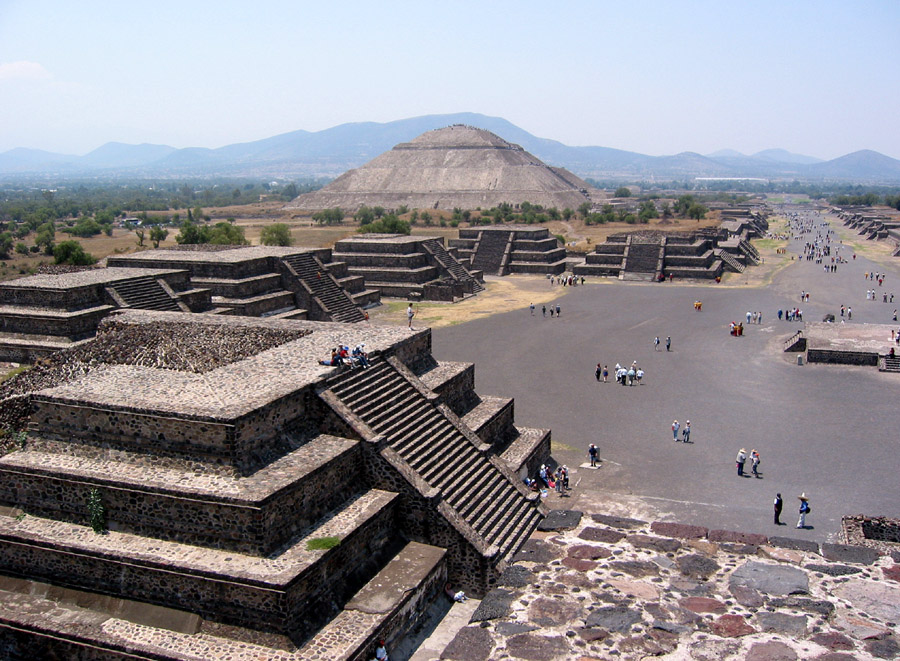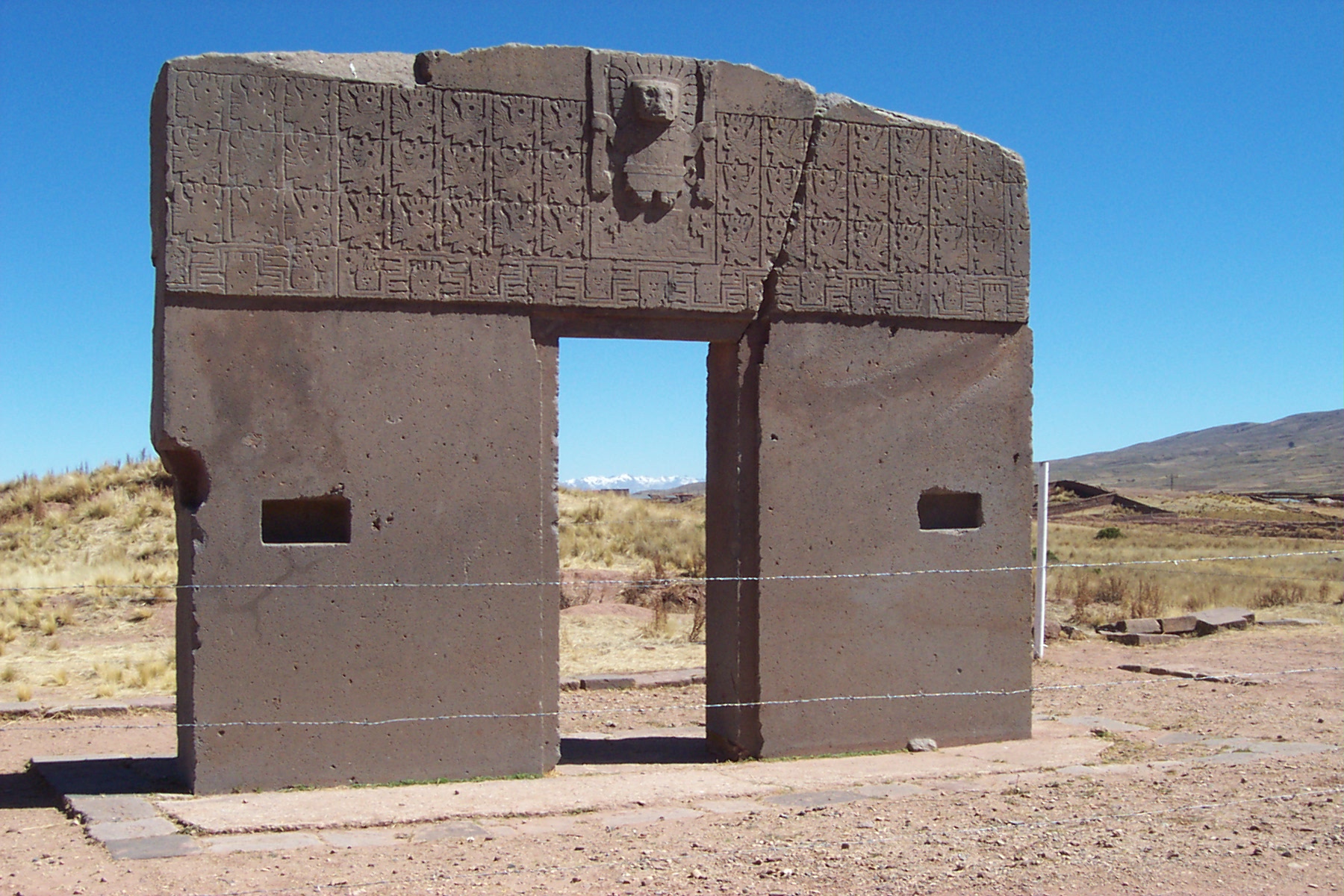|
Wankarani Culture
The Wankarani culture was a formative stage culture that existed from approximately 1500 BCE to 400 CE on the altiplano highlands of Bolivia's Oruro Department to the north and northeast of Lake Poopo. It is the earliest known sedentary culture in Bolivia, as after circa 1200 BCE camelid hunters of the altiplano became camelid herders and sedentary lifestyle developed. The Wankarani culture was little researched before 1970, when Carlos Ponce Sanginés defined all the mound sites in the area as belonging to one culture that predated Tiwanaku and was contemporary with the Chiripa culture. Description Wankarani villages typically consisted of fifteen to five hundred houses. Over the centuries, remains of the adobe bricks and trash created small mounds, on which new houses were built. The dead were buried under the floor of the huts. Wankarani houses were small, round adobe huts painted red on the outside and yellow on the inside. Some villages had up to 4000 inhabitants, but the ... [...More Info...] [...Related Items...] OR: [Wikipedia] [Google] [Baidu] |
Cercado Province (Oruro)
Cercado is a province in the northeastern parts of the Bolivian department of Oruro. Its capital is Oruro. The hamlet of Paria, established in 1535, was the first Spanish settlement in Bolivia and previously had been a regional capital of the Inca Empire. Paria is located in Soracachi municipality. Location Cercado province is one of sixteen provinces in the Oruro Department. It is located between 17° 22' and 18° 35' South and between 66° 21' and 67° 20' West. It borders Tomas Barrón Province and La Paz Department in the northwest, Nor Carangas Province and Saucarí Province in the west, Poopó Province and Pantaléon Dalence Province in the southeast, and Cochabamba Department in the east and north. The province extends over 135 km from North to South, and 105 km from east to west. Geography Some of the highest mountains of the province are listed below: Population The main language of the province is Spanish, spoken by 96.7%, 43.3% of the populati ... [...More Info...] [...Related Items...] OR: [Wikipedia] [Google] [Baidu] |
Quinoa
Quinoa (''Chenopodium quinoa''; , from Quechua ' or ') is a flowering plant in the amaranth family. It is a herbaceous annual plant grown as a crop primarily for its edible seeds; the seeds are rich in protein, dietary fiber, B vitamins, and dietary minerals in amounts greater than in many grains. Quinoa is not a grass, but rather a pseudocereal botanically related to spinach and amaranth (''Amaranthus'' spp.), and originated in the Andean region of northwestern South America. It was first used to feed livestock 5,2007,000 years ago, and for human consumption 3,0004,000 years ago in the Lake Titicaca basin of Peru and Bolivia. The plant thrives at high altitudes and produces seeds that are rich in protein. Almost all production in the Andean region is done by small farms and associations. Its cultivation has spread to more than 70 countries, including Kenya, India, the United States, and in European countries. As a result of increased popularity and consumption in North ... [...More Info...] [...Related Items...] OR: [Wikipedia] [Google] [Baidu] |
Pre-Columbian Archaeological Sites
In the history of the Americas, the pre-Columbian era spans from the original settlement of North and South America in the Upper Paleolithic period through European colonization, which began with Christopher Columbus's voyage of 1492. Usually, the era covers the history of Indigenous cultures until significant influence by Europeans. This may have occurred decades or even centuries after Columbus for certain cultures. Many pre-Columbian civilizations were marked by permanent settlements, cities, agriculture, civic and monumental architecture, major earthworks, and complex societal hierarchies. Some of these civilizations had long faded by the time of the first permanent European colonies (c. late 16th–early 17th centuries), and are known only through archaeological investigations and oral history. Other civilizations were contemporary with the colonial period and were described in European historical accounts of the time. A few, such as the Maya civilization, had their own wr ... [...More Info...] [...Related Items...] OR: [Wikipedia] [Google] [Baidu] |
Pre-Columbian Cultures
This list of pre-Columbian cultures includes those civilizations and cultures of the Americas which flourished prior to the European colonization of the Americas. Cultural characteristics Many pre-Columbian civilizations established permanent or urban settlements, agriculture, and complex societal hierarchies. In North America, indigenous cultures in the Lower Mississippi Valley during the Middle Archaic period built complexes of multiple mounds, with several in Louisiana dated to 5600–5000 BP (3700 BC–3100 BC). Watson Brake is considered the oldest, multiple mound complex in the Americas, as it has been dated to 3500 BC. It and other Middle Archaic sites were built by pre-ceramic, hunter-gatherer societies. They preceded the better known Poverty Point culture and its elaborate complex by nearly 2,000 years. [...More Info...] [...Related Items...] OR: [Wikipedia] [Google] [Baidu] |
Indigenous Culture Of The Americas
Indigenous may refer to: *Indigenous peoples *Indigenous (ecology), presence in a region as the result of only natural processes, with no human intervention * Indigenous (band), an American blues-rock band * Indigenous (horse), a Hong Kong racehorse * ''Indigenous'' (film), Australian, 2016 See also *Disappeared indigenous women *Indigenous Australians *Indigenous language *Indigenous religion Indigenous religions is a category used in the study of religion to demarcate the religious belief systems of communities described as being " indigenous". This category is often juxtaposed against others such as the " world religions" and "new ... * Indigenous peoples in Canada * Native (other) * * {{disambiguation ... [...More Info...] [...Related Items...] OR: [Wikipedia] [Google] [Baidu] |
Archaeological Sites In Bolivia
Archaeology or archeology is the scientific study of human activity through the recovery and analysis of material culture. The archaeological record consists of artifacts, architecture, biofacts or ecofacts, sites, and cultural landscapes. Archaeology can be considered both a social science and a branch of the humanities. It is usually considered an independent academic discipline, but may also be classified as part of anthropology (in North America – the four-field approach), history or geography. Archaeologists study human prehistory and history, from the development of the first stone tools at Lomekwi in East Africa 3.3 million years ago up until recent decades. Archaeology is distinct from palaeontology, which is the study of fossil remains. Archaeology is particularly important for learning about prehistoric societies, for which, by definition, there are no written records. Prehistory includes over 99% of the human past, from the Paleolithic until the advent o ... [...More Info...] [...Related Items...] OR: [Wikipedia] [Google] [Baidu] |
Prehistory Of Bolivia
Pre-Columbian Bolivia covers the historical period between 10,000 BCE, when the Upper Andes region was first populated and 1532, when Spanish conquistadors invaded Inca empire. The Andes region of Pre-Columbian South America was dominated by the Tiwanaku civilization until about 1200, when the regional kingdoms of the Aymara emerged as the most powerful of the ethnic groups living in the densely populated region surrounding Lake Titicaca. Power struggles continued until 1450, when the Incas incorporated upper Bolivia into their growing empire. Based in present-day Peru, the Incas instituted agricultural and mining practices that rivaled those put in place many years later by European conquerors. They also established a strong military force, and centralized political power. Despite their best efforts however, the Incas never completely controlled the nomadic tribes of the Bolivian lowlands, nor did they fully assimilate the Aymara kingdoms into their society. These internal divis ... [...More Info...] [...Related Items...] OR: [Wikipedia] [Google] [Baidu] |
Prehispanic History Of Chile
The precolonial history of Chile refers to the period from the first human populations in the territory of Chile until the first European exploration of the region, by Spaniard Diego de Almagro in 1535-36. There are numerous theories on the settlement of the Americas; the most accepted currently, that of Paul Rivet, states that there were numerous arrivals for different reasons: those leaving Asia via the Bering Straits, but also those traveling from island to island in Polynesia and Melanesia, via Central America. The first people to arrive in the territory of Chile would have been in one of these population movements. The prehistoric site of Monte Verde in Chile, presently under consideration as a World Heritage Site by UNESCO, has provided the oldest dates of habitations in Chile at around 13,000 to 15,000 years for "Monte Verde II." Dates of 33,000 to 35,000 years have been suggested for the "Monte Verde I" site but the evidence is considered too meagre to verify that. Va ... [...More Info...] [...Related Items...] OR: [Wikipedia] [Google] [Baidu] |
Pre-Columbian Bolivia
Pre-Columbian Bolivia covers the historical period between 10,000 BCE, when the Upper Andes region was first populated and 1532, when Spanish conquistadors invaded Inca empire. The Andes region of Pre-Columbian South America was dominated by the Tiwanaku civilization until about 1200, when the regional kingdoms of the Aymara emerged as the most powerful of the ethnic groups living in the densely populated region surrounding Lake Titicaca. Power struggles continued until 1450, when the Incas incorporated upper Bolivia into their growing empire. Based in present-day Peru, the Incas instituted agricultural and mining practices that rivaled those put in place many years later by European conquerors. They also established a strong military force, and centralized political power. Despite their best efforts however, the Incas never completely controlled the nomadic tribes of the Bolivian lowlands, nor did they fully assimilate the Aymara kingdoms into their society. These internal divis ... [...More Info...] [...Related Items...] OR: [Wikipedia] [Google] [Baidu] |
Qaluyu
Qaluyu ( Aymara ''qala'' stone, ''uyu'' corral, "stone corral", also spelled ''Caluyo'') is a mountain in the Chilla-Kimsa Chata mountain range in the Andes of Bolivia. It is located in the La Paz Department, Ingavi Province, Tiwanaku Municipality. Qaluyu is situated south-west of Pukara ''(Pucara)'' and south-east of the archaeological site of Tiwanaku Tiwanaku ( es, Tiahuanaco or ) is a Pre-Columbian archaeological site in western Bolivia near Lake Titicaca, about 70 kilometers from La Paz, and it is one of the largest sites in South America. Surface remains currently cover around 4 square kilo .... The village of Qaluyu ''(Caluyo)'' lies at its feet. (unnamed) References Mountains of La Paz Department (Bolivia) {{LaPazBO-geo-stub ... [...More Info...] [...Related Items...] OR: [Wikipedia] [Google] [Baidu] |


.jpg)
